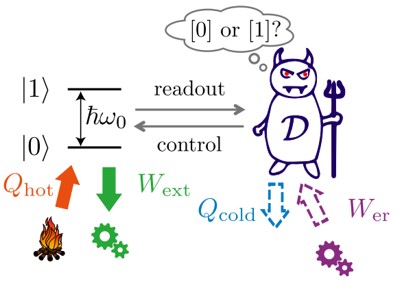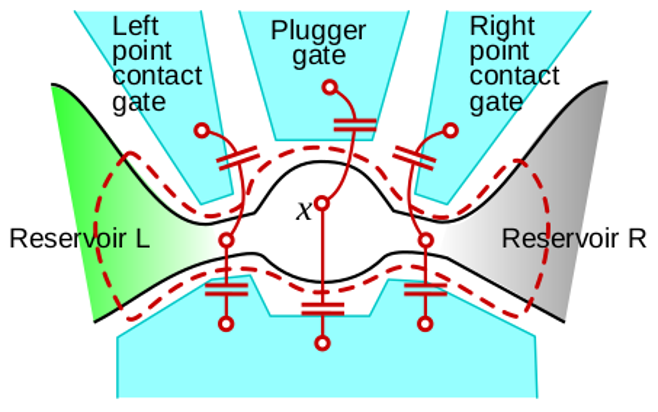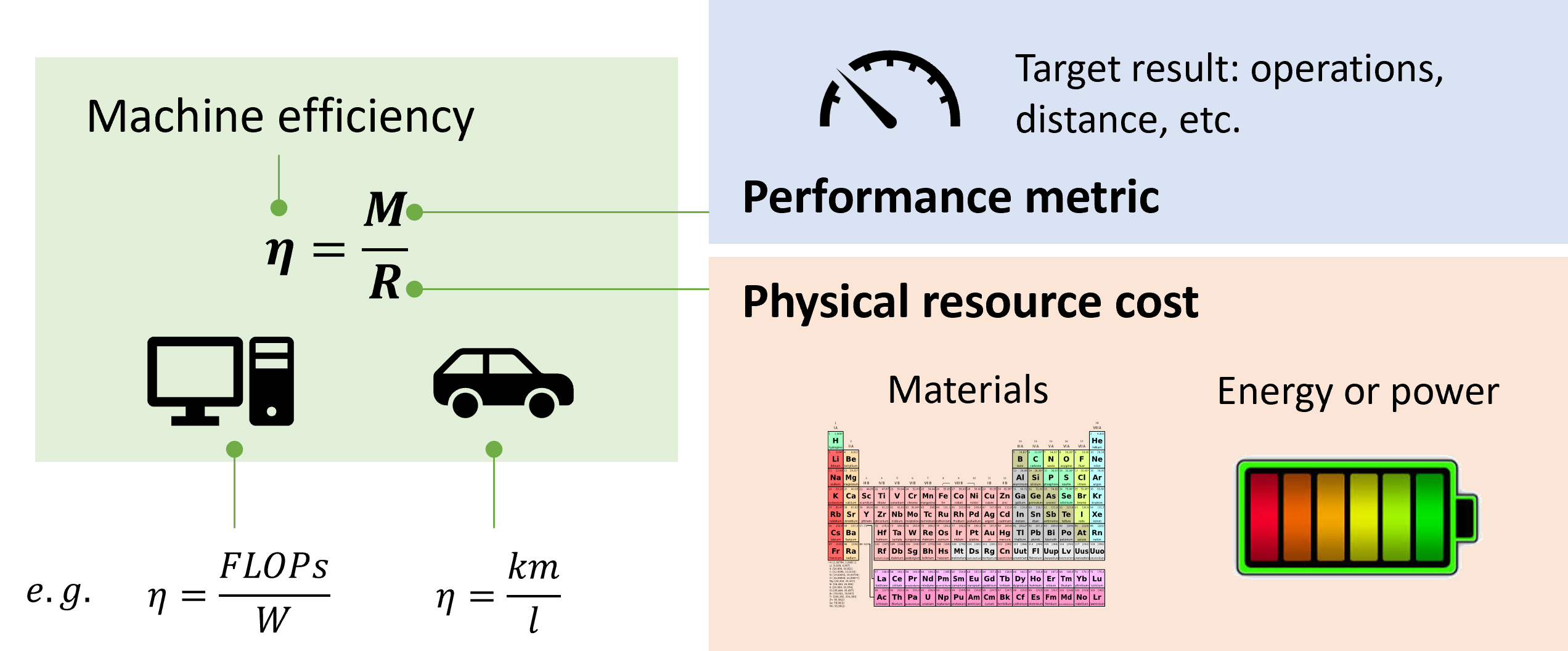Research Topics
Lines of research and results
We explore the links between information, measurement, energy, and entropy in the quantum regime, addressing both fundamental questions and applications to quantum technologies. Our research is inspired by thermodynamics, which was developed to optimize the exploitation of thermal resources to build heat machines, defining fundamental bounds for machine efficiencies.
The quantum realm provides new resources, such as quantum noise and quantum coherence, and exhibits types of irreversibility with no classical equivalents. Temperature is not necessarily defined, nor relevant to explore these new situations. This stimulates new and exciting questions such as the origin of irreversibility at quantum scales, its impact on the efficiency of quantum machines, or the existence of energetic advantages of quantum nature.
To address these questions, we consider simple, canonical situations of quantum physics such as driven quantum systems subjected to projective measurements, or strongly coupled quantum systems. Characterizing the exchanges between parties in such simple systems sheds new light on work, heat, entropy and irreversibility in the quantum realm. It provides building blocks for understanding the energetic and entropic footprint of elementary quantum devices. This provides the tools to evaluate and minimize the energy consumption of quantum technologies, at both the microscopic and macroscopic level. It also opens the path to the study of more complex situations such as quantum systems coupled to out-of-equilibrium reservoirs, and driven-dissipative systems.
We are co-founders of the Quantum Energy Initiative, which pushes for a new transdisciplinary line of research to evaluate and minimize the energy efficiency of quantum technologies.
Fundamental physics
Energetics of quantum measurement
Measuring a quantum system is a primordial protocol in quantum physics. As a major difference with the classical case, quantum measurements not only allow extracting information from quantum systems: they are also primary sources of noise, transferring energy and entropy, just like hot baths do. Such energy transfers can be used as a new kind of fuel for measurement-powered engines, which can run just by being looked at. We are studying the behavior of these engines, both on average and at the stochastic level, in close collaborations with experimental groups. Conversely, quantum measurement has an energetic cost, that we explore by developing autonomous models where the system and the meter constitute closed, isolated systems.

L.L.
Selected references:
- C.Elouard, D. Herrera-Martì, M. Clusel, A. Auffèves, The role of quantum measurement in stochastic thermodynamics, npj QI 3:9 (2017).
- C. Elouard, D. Herrera-Martí, B. Huard, A. Auffèves, Extracting work from quantum measurement in Maxwell demon engines, Phys. Rev. Lett. 118, 260603 (2017). featured in Phys.org https://phys.org/news/2017-07-maxwell-demon-quantum.html and Nature Research Highlights https://www.nature.com/articles/d41586-017-01312-
- L. Bresque, P. Camati, R. Spencers, K. Murch, A. Jordan, A. Auffèves, Two-qubit engine fueled by entanglement and local measurements, Phys. Rev. Lett. 126, 120605 (2021), Editor’s Suggestion, Communication INP, covered in Phys.org.
- X. Linpeng, L. Bresque, M. Maffei, A. N. Jordan, A. Auffèves, and K. W. Murch, Energetic cost of measurements using quantum, coherent and thermal light, Phys. Rev. Lett. 128, 220506 (2022).
Quantum batteries
These are paradigmatic quantum devices aimed to store and deliver energy at will. Their optimization requires the optimization of energy exchanges between quantum systems, and an understanding of how they get impacted by quantum features such as coherence and entanglement. As such, they provide ideal playgrounds to extend the concepts of heat and work exchanges between strongly coupled quantum systems. We are modeling and studying quantum batteries both in waveguide QED and optomechanical devices.
Selected references:
- J. Monsel, M. Fellous-Asiani, B. Huard, A. Auffèves, The energetic cost of work extraction, Phys. Rev. Lett. 124, 130601 (2020).
- M. Maffei, P. Camati, A. Auffèves, Probing nonclassical light fields with energetic witnesses in waveguide quantum electrodynamics, Phys. Rev. Research 3, L032073 (2021).
Quantum systems coupled to non-equilibrium reservoirs
The dynamics and thermodynamics of quantum systems that are weakly coupled to thermal baths are relatively well understood. However, often the reservoir is out-of-equilibrium, sometimes as the by-product of some other physical process, and sometimes because it is strongly perturbed by the quantum system being studied. Then familiar notions like temperature, heat and work become unreliable. In some cases, even the separation between the quantum system and the reservoir becomes unhelpful, as the properties of the quantum system and reservoir together are completely unlike their individual properties (such as when they form a joint bound-state). We study the dynamics and thermodynamics in such situations using a variety of analytic (or semi-analytic) techniques. A particular interest of ours are situations that superficially look like they violate the laws of thermodynamics (Maxwell demons, etc). Our methods can especially be applied to driven-dissipative quantum systems which resist quantum noise, and so are useful as qubits in quantum technologies. These include various kinds of cat-codes, and other kinds of autonomous quantum error correction.

Selected references:
- B.-L. Najera-Santos, P. A. Camati, V. Métillon, M. Brune, J.-M. Raimond, A. Auffèves, and I. Dotsenko, Autonomous Maxwell’s demon in a cavity QED system, Phys. Rev. Research 2, 032025(R) (2020).
- N. Cottet, S. Jezouin, L. Bretheau, P. Campagne-Ibarcq, Q. Ficheux, J. Anders, Alexia Auffèves, R. Azouit, P. Rouchon, B. Huard, Observing a quantum Maxwell demon at work, PNAS 114(29) 7561 (2017).
Platforms and methods
Our team is strongly connected to experimental groups working on various platforms, from neutral atoms, semiconducting nanostructures, superconducting circuits, optomechanical devices to quantum electronic devices and others. We aim to follow experiments from farm to fork, from the build-up of primary concepts, to the design of the experimental protocols and ultimately the data fitting by building analytical models.
Cavity and waveguide quantum electrodynamics. Cavity QED describes the coupling between quantum emitters and single mode cavities. Its conceptual simplicity makes it an ideal platform to study quantum energetics, that we explore with Rydberg atoms in collaboration with the group of I. Dotsenko (Coll!ge de France, LKB, Paris, France).
Waveguide QED extends the concepts of CQED to the case of a one-dimensional reservoir of electromagnetic modes. It captures the physics at play in superconducting circuits and integrated photonics setups. Building on collision models, we provide exact solutions of light-matter dynamical equations. This allows us to study the dynamics and energetics of elementary quantum devices (quantum gates, quantum interfaces, quantum batteries, quantum meters), and quantum open systems, in close collaboration with experimental groups of circuit QED (B. Huard, ENS Lyon, France; K. Murch, Saint Louis Univ., USA) and quantum photonics (P. Senellart, C2N, France)
Selected references:
- Z. Tan, P. A. Camati, G. Coeuret Cauquil, A. Auffèves, I. Dotsenko, Alternative Experimental Ways to access entropy production, Phys. Rev. Research 3, 043076 (2021).
-
S. Wein, J.C. Loredo, M. Maffei, P. Hilaire, A. Harouri, N. Somashi, A. Lemaître, I. Sagnes, L. Lanco, O. Krebs, A. Auffèves, C. Simon, P. Senellart, C. Solanas, Photon-number entanglement generated by sequential excitation of a two-level atom, Nat. Phot., 10.1038/s41566-022-00979-z (2022).
-
J. Stevens, D. Szombati, M. Maffei, C. Elouard, R. Assouly, N. Cottet, R. Dassonneville, Q. Ficheux, S. Zeppetzauer, A. Bienfait, A. N. Jordan, A. Auffèves, and B. Huard, Energetics of a single qubit gate, Phys. Rev. Lett. 129, 110601 (2022).
-
M. Maffei, P.A. Camati, A. Auffèves, A closed system solution of the 1D atom from collision model, Entropy 2022, 24, 151 (2022).
Optomechanics. It is an ideal platform to explore energetic, entropic and informational flows at quantum scales. Optomechanical devices feature quantum emitters coupled to mechanical resonators on the one hand, and electromagnetic reservoirs on the other. The resonator plays the role of a quantum battery, exchanging work with the emitter. In the ultra-strong coupling regime, mechanical energy changes can reveal elementary information to energy conversions, providing new testbeds for quantum Maxwell demon engines, Landauer’s erasure experiments and fluctuation theorems.
Selected references:
- F. Vigneau, J. Monsel, J. Tabanera, K. Aggarwal, L. Bresque, F. Fedele, F. Cerisola, A. Briggs, J. Anders, J. Parrondo, A. Auffèves and N. Ares, Ultrastrong coupling between electron tunneling and mechanical motion, Phys. Rev. Research 4, 043168 (2022).
- J. Monsel, C. Elouard, A. Auffèves, An autonomous quantum machine to measure the thermodynamic arrow of time, npj QI 4:59 (2018).
- C. Elouard, M. Richard and A. Auffèves, Reversible work extraction in a hybrid opto-mechanical system, New J. Physics 17, 055018 (2015).
Quantum nanoelectronics and quantum transport. We use quantum transport techniques to describe electron flows in nanostructures. These allow us to model and understand the physics of energy, entropy, measurement and information in quantum electronic devices, including those consisting of superconducting circuits or spin qubits. They include Landauer scattering theory, and real-time transport theory (a Keldysh theory for non-equilibrium quantum systems.

Selected reference:
- G. Benenti, G. Casati, K. Saito, R.S. Whitney, Fundamental aspects of steady-state conversion of heat to work at the nanoscale, Physics Reports, 694, 1 (2017).
Application: physical resource cost of quantum technologies
Our studies are steppingstones to explore and optimize the energetic footprint of quantum computing, communication and sensing technologies. In a finite world, deploying these technologies requires careful energetic analyses from the ground up. It takes a new transdisciplinary line of research addressing these issues, by providing a metric-noise-resource (MNR) methodology to assess and compare the energy efficiency of quantum technologies in a consistent way. Its overarching idea was first laid out in Alexia Auffèves’ perspective article, Quantum Technologies Need an Energy Initiative published in PRX Quantum in 2022.

Scalable superconducting qubits quantum computers
We first applied the MNR methodology in Optimizing resource efficiencies for scalable full-stack quantum computers (preprint). It enabled a quantification and optimization of various figures of merit of a scalable superconducting qubit-based quantum computer with adopting a full-stack view. It showcases the strong interdependencies between the quantum-nano stacks at the qubit level and the macroscopic level of classical resources (electronics, cryogeny and the likes) that help control qubits and mitigate their noise, on top of the relatively hardware-agnostic layers of applications and algorithms.

Other types of qubits in NISQ and FTQC regime
Our team plans to investigate the energetics of various other types of qubits in the NISQ (noisy qubits in analog and gate-based modes) and FTQC regimes (in gate-based modes) in partnership with various research groups and industry vendors.
Quantum Energy Initiative
The perspective article Quantum Technologies Need an Energy Initiative, led to the creation of the Quantum Energy Initiative (shortened as #QEI). This was formally launched in August 2022 by Alexia Auffèves and Robert Whitney from our team, with Olivier Ezratty, a quantum technology consultant and author who was equally contributing to our research on quantum computing energetics, and Janine Spettstoesser, a professor in theoretical physics in the Applied Quantum Physics Group at the Department of Microtechnology and Nanoscience (MC2) and director of the Excellence Initiative Nano at Chalmers University in Sweden.

The Quantum Energy Initiative missions and goals are to create a transdisciplinary line of research on the energetics of quantum technologies, spur a worldwide research and industry community along these lines, launch collaborative projects to optimize the energetics of quantum technologies and propose related new standards and benchmarking tools. The Quantum Energy Initiative website was launched with a Manifesto and a Poll in order to inventory the goodwill around the initiative and start building its community. It gathered the support and feedback of over 300 individuals coming from 36 countries. It was followed in November 2022 by the announcement of the first partner organizations from the quantum technologies ecosystem which are supporting the Quantum Energy Initiative (research organizations, HPC service providers, industry vendors and industry associations).
In January 2023, a scientific board was created which oversees the various actions of the Quantum Energy Initiative, including organizing its research community, sharing scientific information on its web site, launching a video channel and organizing the first #QEI workshop planned in Singapore in November 2023. Our team remains a scientific driving force behind the Quantum Energy Initiative, along with many other research organizations, experimentalists and industry vendors throughout the world.
